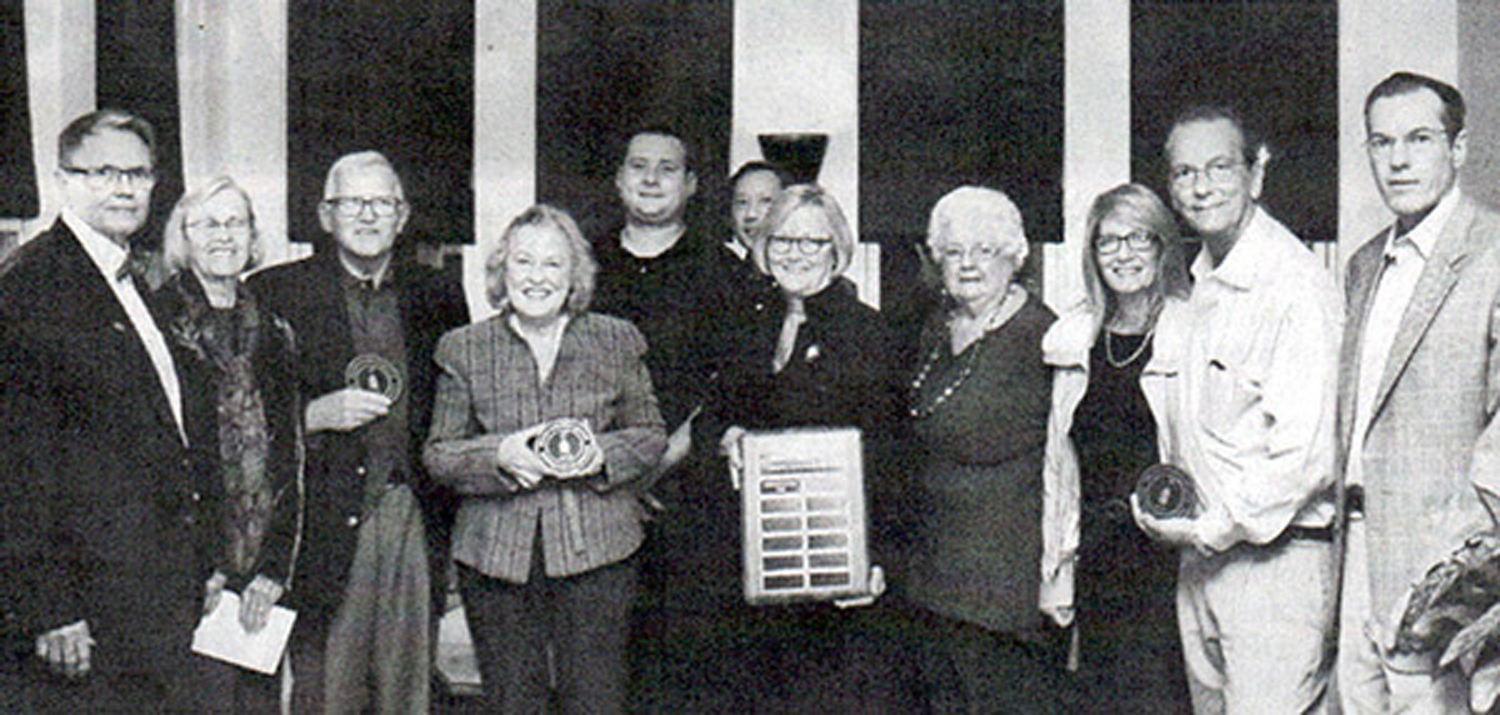News

Trust Honors Stewards of Historic Milford Architecture
MILFORD – Last week, at Hotel Fauchere, the Historic Preservation Trust of Pike County announced the first recipient of their new annual Stewardship Leadership awards program that recognizes community members, outstanding businesspersons and organizations responsible for outstanding restorations and preservation of Historic buildings in Pike County. This year’s recipients are for restorations in Milford Borough. The two annual prize categories are the Thomas W. Hoff Stewardship Medallion and the Richard L Snyder Distinguished Leadership Prize. The award ceremony took place in the Delmonico Room the hotel, located on Broad Street in Milford Borough. The Trust Board member Edgar Brannon, retired U.S. Forest Service Grey Towers director, served as Master of Ceremony. Trust Vice President Bill Kiger gave an introduction on the Trust board’s decision to perpetuate the legacy of Hoff and Snyder with the award program.
The Trust board presented four W. Hoff Stewardship Medallions to the following recipients: Reggie Cheong-leen and Peter Spìelhaugen for their work on preserving the Forest Hall complex, located on Broad and Harford Street; Deb and Paul Brook for their Anthony Brooks Building; Valerie Meyer for her Kiel-Kill-Karr building; Sean Strub and the late Dick Snyder for Hotel Fauchere and the Annex (Emmerson House).
The Trust also presented the Richard L. Snyder Distinguished Leadership Prize lo the Milford Garden Club. Brannon has special expertise on historic preservation. While at Grey Towers, he oversaw a multi-million dollar restoration which included ancillary buildings, grounds, and landscaping. He also served as technical advisor to Hotel Fauchere owners Dick Snyder and Sean Strub during the hotel renovation. Introducing the awards concept, Brannon said “the trust wanted to recognize Tom Hoff’s and Dick Snyder’s immeasurable contribution to historic preservation. The Hoff Medallion recognizes historic structures and landscapes for the owners/caretakers for their stewardship of these historic structures and landscapes. Without the effort of these committed individuals, families, businesses, and organizations the structures would be lost to all of us”. “The Medallion recognizes historic buildings and landscapes that demonstrate the very best of historic restoration or adaptive reuse. The buildings and landscapes are all on the National Register of Historic Places, or in a National Registered District. “Each building’s owner will be presented with a specially designed bronze Medallion that can be placed on the structure.” According to Brannon, the Snyder Prize at a cash award to individuals, families, and organizations or government agencies expressing qualities exemplified by Snyder, such generosity, persistence, and public service. Brannon said, Dick believed that our built environment, the public spaces in particular, are critical to the quality of life and economic vitality of our community.
FOREST HALL
Brannon said that the Trust recognized Cheong-leen and Spielhaugen for their dedication in caring for the structure since they purchased the building from a group of local partners who were committed to seeing the building preserved and protected. Brannon described the monumental building as distinguished by the high caliber at architects involved in its unique masonry construction. James Wallace Pinchot (1829-1908) commissioned Forest Hall Architect Calvert Vaux designed the main part of the building. As architect Frederic Law Olmsted partner, Vaux also helped design New York City Central Park. The part of the Forest Hall designed by him also served as the Milford Post Office. An attached building to Forest Hall housed classroom space and an auditorium for the Yale School of Forestry. Hunt and Hunt, the successors of Richard Morris Hunt, the designer of Grey Towers, designed that part of the complex. James Wallace Pinchot’s son Gifford (1865-1946) was a leading proponent of academic study of forestry. Brannon said. “Forest Hail stands as a model for long-term stewardship. The historic fabric of the building has been preserved, carefully repaired, and in some cases appropriately replaced. Forest Hall looks today much like it did over a century ago when it was built.
 ANTHONY BROOKS BUILDING
ANTHONY BROOKS BUILDING
The second medallion recognizes, the Anthony Brooks, restored by Deb and Paul Brooks, is located at 200 East Harford Street. It currently houses Ambiance Furniture and Fine gifts, Progressive Health, and two apartments. The building is two-and-half story Greek Revival. The historic “Sanborn Fire Maps’” list the building as having been a general store in 1885. a grocery store in 1905, Milford Steam Laundry in 1928, and the Alvin Blitz Garage in the 1940 and 1950. Robert Kris (spokesperson for Broadpath, a Philadelphia public relations firm) said. ln April of 2013 an electrical fire destroyed the buildings timber frame and severely damaged the brick façade. Committed to replacing every historical detail of the building, (Deb and Paul Brooks) retained Richard Pedranti Architect to do a sensitive historic restoration, but Pedranti found a way to replicate the original building. Pedranti is a member of the trust board.

Owner Paul Brooks, contractor Ken Shino, owner Deb Brooks, and Architect Richard Pedranti
Brannon said, “The Anthony Brooks Building represents an exceptional example of rehabilitation of an historic structure to serve a contemporary use. Paul and Deb Brooks have done an outstanding job of stewardship. Deb Brooks said. “Milford is very proud of its historic buildings and the Anthony Brooks Building is an essential element to the fabric of the Borough. The fact that Richard appreciates the importance of preserving our town’s great history while simultaneously employing modern energy-efficient design made him an easy choice for the job. Pedranti said that he “engineered the building to high performance 21st century energy efficient standards that “provide tenant and customers with a comfortable living and shopping space.”
KIEL-KILL-KARE
The third building, now owned by Valerie Meyer, Milford Shade Tree commission/manager, KieI-KiII-Kare, located at 215 W. It is a 2 ½ story Greek Revival style residence, built in 1835 for Augustus Kiel, known as the “Marble King.” According to Meyer, subsequent owners of the Kiel House expanded it over the years. Many other owners of 19th century houses in the borough also expanded their homes. Brannon said that Meyer lovingly restored the house and garden, paying particular attention to the restoration of the landscape and its original garden features, the garden house and the marble pool. She said. “I was deeply touched by the recognition I was honored to receive it.”
HOTEL FAUCHERE
The Trusts fourth recognition is the Hotel Fauchere and the Annex, known as the Emerson house, restored by Sean Strub and the late Dick Snyder. Brannon described the hotel as a wood-framed, three-story, Italian Villa style resort that was built by Louis Fauchere (1823-1893). Fauchere, who emigrated from Switzerland to New York City in 1851, had worked in the hotel industry in Europe. He is credited with developing the concept af a menu while working in New York. Hotel Fauchere was a popular resort that catered to prominent New Yorkers and Philadelphians. Brannon noted the guests included many prominent people, such as actress Sarah Bernhardt and members of the Rockefeller family. The Fauchere family owned it for over 100 years. After they sold it the building was used as offices for physicians. It fell into disrepair and the cost to maintain it became too high. Snyder and Strub purchased the building and Annex, invested 8 million on the initial restoration, and had a goal of restoring it to its former 19th century and early 20th century glory. Brannon said, this building is now an anchor of the commercial district and one of the most photographed buildings in the borough. He said that Strub manages the hotel, which is part of the international prestigious Relais and Chateaux HoteIs.
According to Brannon the trust set up the Richard L. Snyder distinguished Leadership Prize to recognize an individual, business, organization, or government entity for exemplary and sustained leadership in preserving, promoting, and/or enhancing via restoration or adaptive reuse, all or part of the building or environment.
MILFORD GARDEN CLUB
Brannon announced that this year’s Richard L Snyder Distinguished Leadership Prize is the Milford Garden Club. The award in a cash prize at $1,000 which came from a grant awarded to the trust from the Greater Pike Foundation. According to Brannon, in 1937, 12 ladies from Milford and Matamoras, including the late Georgiana Kiger, established the club with the express purpose of “learning about horticulture and beautifying Milford, the county seat. For more than 75 years, The Milford Garden Club has more than lived up to its mission. It is impossible to put a monetary value on their work. Brannon said that the scope of the clubs historic projects included continuing the Tree Bee (a precursor of the Milford shade tree commission), which planted more than 600 decorative shade trees in Milford borough between 1952 to 1979, planting hundreds of trees since then, developing Ann Street Memorial Park (with Milford Matamoras Lions Club), maintain tehe three mini gardens that grace Milford Borough’s entrances, and maintaining Remembrance Place park off West Ann Street in Milford Borough. The club also maintains planters and urns throughout Milford Borough, maintains the Community Pantry Garden at the Milford township building that feeds more than 60 families a week with fresh produce, and is a participant in the Milford Enhancement Committee that is responsible for streetscape upgrades to Milford Borough. According to Brannon the club has also helped do the following:
- Register 18 year olds to vote
- Transplant trees from the wild to Milford streets
- Plant victory gardens during WWII
- Promote Community planting and zoning in the 1960’s and 1970’s when those concepts were being introduced to Pennsylvania municipalities by the Penn State Cooperative Extension
- Helped administer Polio Vaccines, administered the X-ray mobile committee
- Run an anti-liter campaign.

